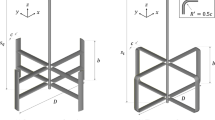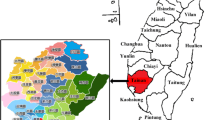Abstract
Investigating laminar separation over the turbine blade of a horizontal-axis wind turbine (HAWT) has been considered an important task to improve the aerodynamic performance of a wind turbine. To better understand the laminar separation phenomena, in this study, the aerodynamic forces of a SD8000 airfoil (representing the sectional blade shape) in the steady-state conditions were first predicted using an incompressible Reynolds-averaged Navier–Stokes solver with the γ–Re θt and k–k L–ω transition models. By comparing simulation and experimental results, the k–k L–ω transition model was chosen to simulate the laminar separation on three-dimensional (3D) turbine blade. Experimentally, a HAWT with three blades was then tested in a close-circuit wind tunnel between the tip speed ratios (TSRs) of 2 and 7 at the wind speed of 10 m/s. In addition, through computational fluid dynamics, the turbine performance and flow characteristics on the blade as blade is rotating were investigated. It is shown that 3D simulations agreed well with the experimental results with regard to the mechanical power of the HAWT at the testing TSRs. Moreover, the separation and reattachment lines on the suction surface of the turbine blade were also observed through the skin friction line, indicating that laminar separation moved toward the trailing edge with the increasing TSR at the blade tip region.









Similar content being viewed by others
References
Bai CJ, Hsiao FB (2010) Code development for predicting the aerodynamic performance of a HAWT blade with variable-operation and verification by numerical simulation. Paper presented at the 17th National Computational Fluid Dynamics Conference, Taoyuan, Taiwan, July 2010
Bai C-J, Wang W-C, Chen P-W, Chong W-T (2014) System integration of the horizontal-axis wind turbine: the design of turbine blades with an axial-flux permanent magnet generator. Energies 7:7773
Bai C-J, Chen P-W, Wang W-C (2016) Aerodynamic design and analysis of a 10 kW horizontal-axis wind turbine for Tainan. Taiwan Clean Technol Environ Policy 18:1151–1166. doi:10.1007/s10098-016-1109-z
Bassi F, Crivellini A, Rebay S, Savini M (2005) Discontinuous Galerkin solution of the Reynolds-averaged Navier–Stokes and k–ω turbulence model equations. Comput Fluids 34:507–540. doi:10.1016/j.compfluid.2003.08.004
Bechmann A, Sørensen NN, Zahle F (2011) CFD simulations of the MEXICO rotor. Wind Energy 14:677–689. doi:10.1002/we.450
Byerley AR, Störmer O, Baughn JW, Simon TW, Van Treuren KW, List J Jr (2003) Using Gurney flaps to control laminar separation on linear cascade blades. J Turbomach 125:114–120. doi:10.1115/1.1518701
Chaviaropooulos PK, Hansen MOL (2000) Investigating three-dimensional and rotational effects on wind turbine blades by means of a quasi-3D Navier–Stokes solver. J Fluids Eng 122:330–336
Digraskar DA (2010) Simulations of flow over wind turbines. Master Thesis, Department of Mechanical and Industrial Engineering, University of Massachusetts, Amherst
Genç MS, Kaynak U, Lock GD (2009) Flow over an aerofoil without and with a leading-edge slat at a transitional Reynolds number. Proc Inst Mech Eng G 223:217–231. doi:10.1243/09544100JAERO434
Genç MS, Kaynak Ü, Yapici H (2011) Performance of transition model for predicting low Re aerofoil flows without/with single and simultaneous blowing and suction. Eur J Mech B 30:218–235. doi:10.1016/j.euromechflu.2010.11.001
Genç MS, Karasu İ, Hakan Açıkel H (2012) An experimental study on aerodynamics of NACA2415 aerofoil at low Re numbers. Exp Therm Fluid Sci 39:252–264. doi:10.1016/j.expthermflusci.2012.01.029
Herráez I, Stoevesandt B, Peinke J (2014) Insight into rotational effects on a wind turbine blade using Navier–Stokes computations. Energies 7:6798
Hirahara H, Hossain MZ, Kawahashi M, Nonomura Y (2005) Testing basic performance of a very small wind turbine designed for multi-purposes. Renew Energy 30:1279–1297. doi:10.1016/j.renene.2004.10.009
Hsiao F-B, Bai C-J, Chong W-T (2013) The performance test of three different horizontal axis wind turbine (HAWT) blade shapes using experimental and numerical methods. Energies 6:2784–2803. doi:10.3390/en6062784
Huang J, Corke TC, Thomas FO (2006) Unsteady plasma actuators for separation control of low-pressure turbine blades. AIAA J 44:1477–1487. doi:10.2514/1.19243
Kang HS, Meneveau C (2010) Direct mechanical torque sensor for model wind turbines. Meas Sci Technol 21:1–10. doi:10.1088/0957-0233/21/10/105206
Langtry R, Janusz G, Florian M (2006) Predicting 2D airfoil and 3D wind turbine rotor performance using a transition model for general CFD codes. In: 44th AIAA aerospace sciences meeting and exhibit. Aerospace sciences meetings. American Institute of Aeronautics and Astronautics. doi:10.2514/6.2006-395
Lian Y, Shyy W (2007) Laminar–turbulent transition of a low Reynolds number rigid or flexible airfoil. AIAA J 45:1501–1513. doi:10.2514/1.25812
Malan P, Suluksna K (2009) Calibrating the gamma-Re_theta transition model for commercial CFD. In: The 47th AIAA aerospace sciences meeting, Orlando, Florida, January 2009
Menter FR (1994) Two-equation eddy-viscosity turbulence models for engineering applications. AIAA J 32:1598–1605. doi:10.2514/3.12149
Menter FR, Langtry RB, Likki SR, Suzen YB, Huang PG, Völker S (2004) A correlation-based transition model using local variables—Part I: model formulation. J Turbomach 128:413–422
O’Meara M, Mueller TJ (1987) Laminar separation bubble characteristics on an airfoil at low Reynolds numbers. AIAA J 25:1033–1041. doi:10.2514/3.9739
Pape AL, Lecanu J (2004) 3D Navier–Stokes computations of a stall-regulated wind turbine. Wind Energy 7:309–324. doi:10.1002/we.129
Richards PJ, Hoxey RP (1993) Appropriate boundary conditions for computational wind engineering models using the k–ϵ turbulence model. J Wind Eng Ind Aerodyn 46–47:145–153. doi:10.1016/0167-6105(93)90124-7
Rist U, Maucher U (2002) Investigations of time-growing instabilities in laminar separation bubbles. Eur J Mech B 21:495–509
Schlichting H, Gersten K (2003) Boundary layer theory, 8th edn. Springer, Berlin
Selig MS, McGranahan BD, Broughton BA (1995) Summary of low-speed airfoil data. SoarTech Publications, Virginia Beach
Shan H, Jiang L, Liu C (2005) Direct numerical simulation of flow separation around a NACA 0012 airfoil. Comput Fluids 34:1096–1114. doi:10.1016/j.compfluid.2004.09.003
Sharma DM, Poddar K (2010) Investigations on quasi-steady characteristics for an airfoil oscillating at low reduced frequencies. Int J Aerosp Eng 2010:1–11. doi:10.1155/2010/940528
Shih T-H, Liou WW, Shabbir A, Yang Z, Zhu J (1995) A new k–ϵ eddy viscosity model for high Reynolds number turbulent flows. Comput Fluids 24:227–238. doi:10.1016/0045-7930(94)00032-T
Singh NK, Sarkar S (2011) DNS of a laminar separation bubble. World Acad Sci Eng Technol 5:403–407
Spera DA (1994) Wind turbine technology: fundamental concepts of wind turbine engineering. ASME Press, New York
Stapleton KW, Guentsch E, Hoskinson MK, Finlay WH (2000) On the suitability of k–ε turbulence modeling for aerosol deposition in the mouth and throat: a comparison with experiment. J Aerosol Sci 31:739–749. doi:10.1016/S0021-8502(99)00547-9
Swanson TA, Isaac KM (2010) Planform and camber effects on the aerodynamics of low-Reynolds-number wings. J Aircr 47:613–621. doi:10.2514/1.45921
Walters DK, Leylek JH (2004) A new model for boundary layer transition using a single-point RANS approach. J Turbomach 126:193–202
Acknowledgments
This work was supported by the Ministry of Science and Technology, Taiwan, through Grant NSC 102-2221-E-006-084-MY3.
Author information
Authors and Affiliations
Corresponding author
Rights and permissions
About this article
Cite this article
Bai, CJ., Wang, WC. & Chen, PW. Experimental and numerical studies on the performance and surface streamlines on the blades of a horizontal-axis wind turbine. Clean Techn Environ Policy 19, 471–481 (2017). https://doi.org/10.1007/s10098-016-1232-x
Received:
Accepted:
Published:
Issue Date:
DOI: https://doi.org/10.1007/s10098-016-1232-x




